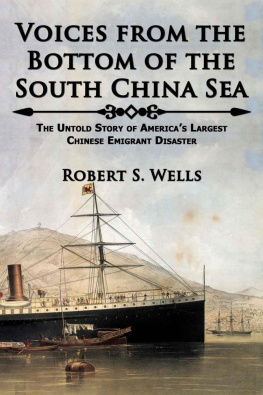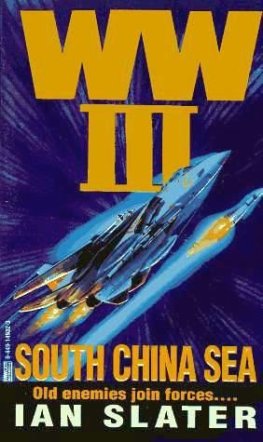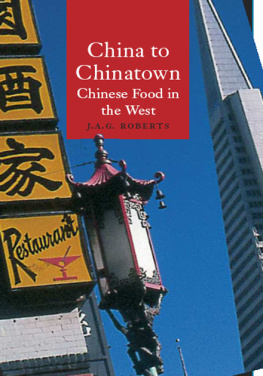Captain Warsaw and the S.S. Colorado
Captain Edward R. Warsaw Life and Service
U.S. Consulate Hong Kong Cable
U.S. Consulate Hong Kong Cable
Illustrations
Figure 1: The 1906 San Francisco Earthquake destroyed the records
Figure 2: President Abraham Lincoln
Figure 3: Presentation of Anson Burlingame at the White House
Figure 4: The Route of the Pacific Mail Steamship Company (1868)
Figure 5: Launch of the Sea Steamer Great Republic
Figure 6: The American-shallow-draft steamer Kin- shan
Figure 7: The Colorado at Hong Kong after her 1867 maiden voyage
Figure 8: Samuel Clemens becoming Mark Twain 1867
Figure 9: Mark Twains possible view of the Pacific Mail docks
Figure 10: Saloon Plan of the Japan
Figure 11: Captain Edward R. Warsaw (April 1871)
Figure 12: Anna Weeks Warsaw (April 1871)
Figure 13: Miss Hattie L Warsaw (April 1871)
Figure 14: AMCONSUL Hong Kong Immigration Certificate
Figure 15: U.S. Immigration Certification to Prevent Coolie Trade
Figure 16: The Coming Man- Chinese passengers at sea
Figure 17: Distributing food rations for the days meal
Figure 18: The Colorado underway (1870)
Figure 19: A mid-day lunch enroute to California
Figure 20: Meeting of the Steamers in Mid-Ocean
Figure 21: The Farallon Islands (1870s)
Figure 22: Pacific Mail Steamship San Francisco arrival
Figure 23: Chinese Immigrants, Customs House, San Francisco
Figure 24 : Chinese immigration (1867-1876)
Figure 25: Chinese Population in California (1872)
Figure 26: President Ulysses S. Grant, (1869-1877)
Figure 27: Pitcher presented to Captain Warsaw
Figure 28: Pacific Mail Steamship Company steamer Japan
Figure 29: Sole surviving log of the Japan (May 1874)
Figure 30: A rare order for the Japan to proceed to sea (1871)
Figure 31: Dining saloon of the America; Japans sister ship
Figure 32: Representative Pacific Mail Officers in uniform
Figure 33: Sunday Service on Board a Pacific Mail Steamship
Figure 34: The burning of the America, Yokohama, ( August 1872)
Figure 35: Chinese emigrant making Joss offering (1871)
Figure 36: A representative home in Guangdong Province (1871)
Figure 37: A handsome girl of 16 will command a price
Figure 38: The Chinese emigrants were screened at Canton
Figure 39: The Japan in Hong Kong after maiden voyage (1868)
Figure 40: Pacific Mail Steamship Japan. (1870s)
Figure 41: Skeleton Map of Swatow revealing final wreck site (1875)
Figure 42: Map of Japan (1871)
Figure 43: An artists conception of the Japan fire. (Dec. 17, 1874)
Figure 44: Chinese Trading Junk (1873)
Figure 45: USS YANTIC, Courtesy U.S. Navy
Figure 46: USS SACO, Courtesy U.S. Navy
Figure 47: Secretary of State Hamilton Fish
Figure 48: Child getting hands burned by a Pacific Mail subsidy
Figure 49: Captain John Pratt Roberts (1867)
Figure 50: A deep water view from the 1874-1876 period
Figure 51: Salvage hooked up (1874-1876)
Figure 52: Picture of the 1874 U.S. Trade Dollar
Figure 53: Final Resting Place of S.S. Japan in South China Sea
Figure 54: Watch presented to Capt. Edward R. Warsaw
Figure 55: USS MONOCACY in the 1890s
Figure 56: A stern eagle
This gripping historical account brings to life the long-forgotten details of the tragic and fiery loss of the S.S. Japan, those who sailed aboard her, and the deepest underwater treasure salvage operation of its day. We live for stories like these. The real treasure here is that Bob has discovered a new underwater cultural heritage site in the South China Sea for both the U.S. and China to honor.
Mark Gordon, President, Odyssey Marine Exploration
It is the greatest maritime disaster in Chinese-American history. In the West, its an untold story, but in China it marks a potent reminder of the countrys first embrace of the American dream, a moment that even today mingles a sense of promise with the pang of grief. The wreck of the SS Japan lies in an area of enormous geo-political and military sensitivity, but we believe that its discovery and recovery provides an important opportunity for dialogue between the two greatest powers in the world. There are forgotten voices at the bottom of the South China Seanow is the time for them to speak.
Jason Williams, Multiple Emmy Award Winning Producer of Treasure Quest; President, JWM Productions
Good to see one of my former UCLA students succeed in the U.S. Navy, the White House and now with his effort bringing to life new history that describes how Chinese emigrants in the post-civil war era got to San Francisco to begin their contributions to America. This well told story has it all-the story of two peoples, life at sea and treasure. A good yarn.
Robert Dallek , Presidential Historian
Captain Bob Wells research has produced an important story on how the Chinese emigrants arrived in San Francisco to provide the essential skills needed for the nation's and my home state of Wyomings successful growth as railroad workers. Bobs well researched story contributes to our understanding of the Chinese contribution and for me, adds important perspective to Wyomings history along those same railroad lines that I used to walk along in my youth.












